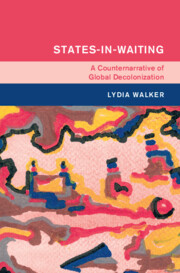6088 results

The Cambridge Companion to John Clare
- Coming soon
-
- Expected online publication date:
- September 2024
- Print publication:
- 30 September 2024
-
- Book
- Export citation
Core Topics in Paediatric Anaesthesia
- Coming soon
-
- Expected online publication date:
- August 2024
- Print publication:
- 31 August 2024
-
- Book
- Export citation

Yukikaze's War
- The Unsinkable Japanese Destroyer and World War II in the Pacific
- Coming soon
-
- Expected online publication date:
- June 2024
- Print publication:
- 06 June 2024
-
- Book
- Export citation

Hitler's Atomic Bomb
- History, Legend, and the Twin Legacies of Auschwitz and Hiroshima
- Coming soon
-
- Expected online publication date:
- June 2024
- Print publication:
- 18 July 2024
-
- Book
- Export citation

States-in-Waiting
- A Counternarrative of Global Decolonization
- Coming soon
-
- Expected online publication date:
- May 2024
- Print publication:
- 16 May 2024
-
- Book
- Export citation
Consistently inconsistent: the false promise of ‘sustainable’ plastics
-
- Journal:
- Cambridge Prisms: Plastics / Accepted manuscript
- Published online by Cambridge University Press:
- 23 April 2024, pp. 1-12
-
- Article
-
- You have access
- Open access
- Export citation
The impact of social-environmental factors on IQ in syndromic intellectual developmental disabilities
-
- Journal:
- Journal of Clinical and Translational Science / Volume 8 / Issue 1 / 2024
- Published online by Cambridge University Press:
- 05 April 2024, e59
-
- Article
-
- You have access
- Open access
- HTML
- Export citation
Beyond Expropriation Without Compensation
- from Introduction
-
-
- Book:
- Beyond Expropriation Without Compensation
- Published online:
- 28 March 2024
- Print publication:
- 04 April 2024, pp 3-32
-
- Chapter
-
- You have access
- Open access
- HTML
- Export citation
9 - Land Reform and Beyond in Times of Social–Ecological Change
- from Part II - Potentials and Pitfalls of South African Land Reform
-
-
- Book:
- Beyond Expropriation Without Compensation
- Published online:
- 28 March 2024
- Print publication:
- 04 April 2024, pp 214-238
-
- Chapter
-
- You have access
- Open access
- HTML
- Export citation
Part I - The Rights and Wrongs of South African Property Law
-
- Book:
- Beyond Expropriation Without Compensation
- Published online:
- 28 March 2024
- Print publication:
- 04 April 2024, pp 33-140
-
- Chapter
-
- You have access
- Open access
- HTML
- Export citation
Acknowledgements
-
- Book:
- Beyond Expropriation Without Compensation
- Published online:
- 28 March 2024
- Print publication:
- 04 April 2024, pp xviii-xx
-
- Chapter
-
- You have access
- Open access
- HTML
- Export citation
Contents
-
- Book:
- Beyond Expropriation Without Compensation
- Published online:
- 28 March 2024
- Print publication:
- 04 April 2024, pp vii-viii
-
- Chapter
-
- You have access
- Open access
- HTML
- Export citation
Copyright page
-
- Book:
- Beyond Expropriation Without Compensation
- Published online:
- 28 March 2024
- Print publication:
- 04 April 2024, pp vi-vi
-
- Chapter
-
- You have access
- Open access
- HTML
- Export citation
Table of Legislation
-
- Book:
- Beyond Expropriation Without Compensation
- Published online:
- 28 March 2024
- Print publication:
- 04 April 2024, pp xxiii-xxiv
-
- Chapter
-
- You have access
- Open access
- HTML
- Export citation
Table of Cases
-
- Book:
- Beyond Expropriation Without Compensation
- Published online:
- 28 March 2024
- Print publication:
- 04 April 2024, pp xxi-xxii
-
- Chapter
-
- You have access
- Open access
- HTML
- Export citation
Notes on Contributors
-
- Book:
- Beyond Expropriation Without Compensation
- Published online:
- 28 March 2024
- Print publication:
- 04 April 2024, pp x-xvii
-
- Chapter
-
- You have access
- Open access
- HTML
- Export citation
Index
-
- Book:
- Beyond Expropriation Without Compensation
- Published online:
- 28 March 2024
- Print publication:
- 04 April 2024, pp 298-310
-
- Chapter
-
- You have access
- Open access
- HTML
- Export citation
List of Figures
-
- Book:
- Beyond Expropriation Without Compensation
- Published online:
- 28 March 2024
- Print publication:
- 04 April 2024, pp ix-ix
-
- Chapter
-
- You have access
- Open access
- HTML
- Export citation
Part III - Imagining Alternative Futures of Redistributive Justice in South Africa
-
- Book:
- Beyond Expropriation Without Compensation
- Published online:
- 28 March 2024
- Print publication:
- 04 April 2024, pp 239-297
-
- Chapter
-
- You have access
- Open access
- HTML
- Export citation
Part II - Potentials and Pitfalls of South African Land Reform
-
- Book:
- Beyond Expropriation Without Compensation
- Published online:
- 28 March 2024
- Print publication:
- 04 April 2024, pp 141-238
-
- Chapter
-
- You have access
- Open access
- HTML
- Export citation



